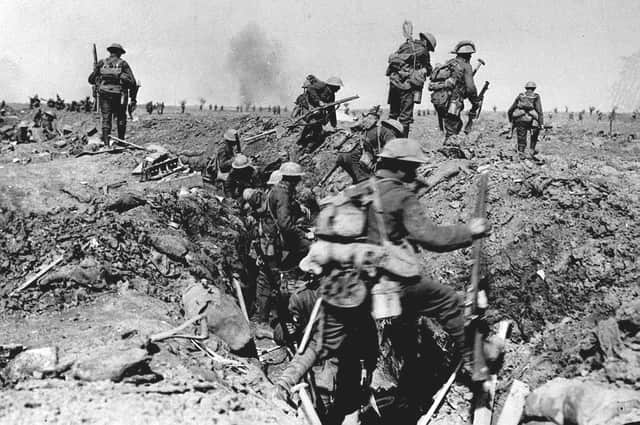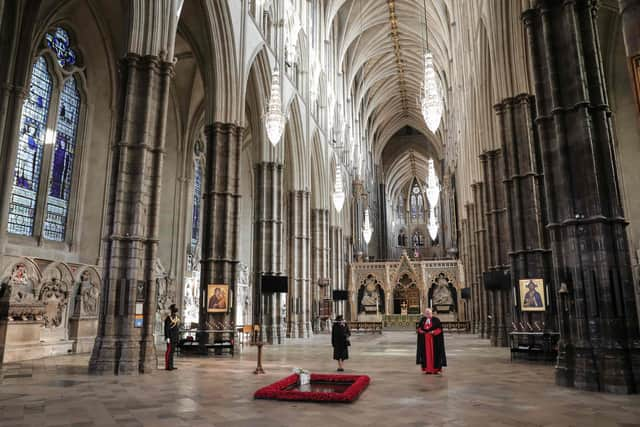Remembrance Day: The story of the Unknown Warrior is a humbling reminder of the folly of war – Stephen Jardine


In 1940 the Royal Navy destroyer was bombed at sea, killing the captain and 11 members of the crew. However, its place in the history books stems not from that tragedy but from a night in Boulogne 20 years before.
A century ago yesterday, HMS Verdun carried the body of the Unknown Warrior from France to England for burial.
Advertisement
Hide AdAdvertisement
Hide AdThe ship was selected for the journey because her name was a tribute to the French people and the slaughter they had endured at the Battle of Verdun. To reciprocate, the body of the Unknown Warrior was escorted to the ship by an entire company of French soldiers who had just received the Legion d’Honneur for bravery. On the quayside, the commander of French forces General Foch stood at salute until HMS Verdun disappeared into the mist, heading for Dover.
The following day the Unknown Warrior was laid to rest in a specially constructed tomb in Westminster Abbey. To this day, the bell from HMS Verdun hangs nearby. The grave was filled with soil brought from the French battlefield. The ceremony was filled with symbolism and poignancy.
The King and leading military and political figures were present but newspaper coverage at the time focussed on other individuals. One hundred holders of the Victoria Cross filed past the tomb as did one hundred widows who had lost their husbands and sons to the war.
When the official ceremony was over and the tomb sealed with black Belgian marble, the doors of Westminster Abbey were opened and the vast crowds waiting outside were allowed in to pay their respects. On that first day alone more than 40,000 passed through the Abbey. By the end of November, 1.5 million people had made the pilgrimage to the grave and to the Cenotaph in Whitehall which had also just been unveiled.


Chaos of battle
Today, society seems to be more fractious and divided than ever. We are fighting our own wars but this time it is over culture and identity rather than territory. We can’t even all agree to wear face masks during a pandemic so the idea of a society united by the funeral of someone they didn’t even know seems to belong to a thousand rather than a hundred years ago.
However, as with all history, we have to put ourselves in the time events happened to understand why they happened.
Apart from a very few officers in 1914, all those killed during the First World War were buried in or near the battlefield and, for many, that meant the Western Front. Bereaved families besieged the War Office with pleas for information. In the chaos of battle, the best most could hope for would be a map reference for a grave but visiting to pay respects was usually out of the question.
On top of that, there was the issue of the 100,00 British soldiers who were still missing, presumed dead at the end of the war with no known final resting place. In the corner of a small garden in Armentiers, army chaplain Rev David Railton spotted a white wooden cross with the words “An Unknown British Soldier”. At that moment an idea was born.
Advertisement
Hide AdAdvertisement
Hide AdNo one should ever know
It took Railton years to persuade the authorities, but on November 7, 1920, burial teams were sent out to all the main battlefields of the Western Front with orders to recover a body from each. They were to check the remains had no visible signs of identification and then transport them under a Union Jack flag to the chapel at British Army headquarters at St Pol.
At midnight, the officer in charge of British troops in France and Flanders Brigadier Wyatt walked into the chapel and randomly pointed at a coffin. The journey home for the Unknown Warrior had begun.
For the operation to work, it had to be cloaked in utter secrecy. Wyatt rarely talked about it in later life but wrote one letter to a newspaper to correct inaccuracies surrounding the story. One thing was crucial, no one should ever be able to guess the identity of the selected soldier.
The Unknown Warrior was a bold attempt to assuage the grief of a nation and calm the growing anger over the colossal scale of mortality but it would only work if every person in the land could reasonably believe it was their son, father, uncle or brother who lies buried in Westminster Abbey.
Ultimate symbol of sacrifice and loss
The fanatical secrecy surrounding the selection process means that bond between the Unknown Warrior and the people of this country remains unbroken. Almost every family in Scotland has some sort of connection back to the Great War. By extension, we watch today’s commemorative ceremony at Westminster Abbey in the knowledge that the enigma of his identity creates a golden thread between now and then.
Time has moved on and DNA technology now helps us unlock some remaining secrets from the war. Just last year, two soldiers were properly identified following analysis of scraps of uniform after their remains were found by a householder digging an extension in their garden near the battlefields of the Somme.
We all love to solve a mystery but the tomb in Westminster Abbey is one enigma we don’t need to clear up. For a hundred years, the Unknown Warrior has exerted a power over us as the ultimate symbol of sacrifice and loss.
At a time when we are more divided than ever, he remains a humbling reminder of the folly of war but also the universality of human existence.
A message from the Editor:
Thank you for reading this article. We're more reliant on your support than ever as the shift in consumer habits brought about by coronavirus impacts our advertisers.
If you haven't already, please consider supporting our trusted, fact-checked journalism by taking out a digital subscription.
Comments
Want to join the conversation? Please or to comment on this article.